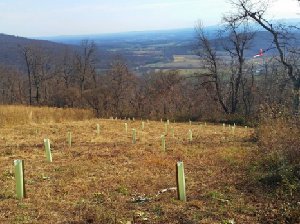An interview with PEC’s Sustainable Habitat Program Assistant Celia Vuocolo
What type of restoration happened at the Overlook this past fall?
 We did a large forest-edge planting of about 2,000 trees and shrubs. The goal was to create a “soft edge” where the forest meets the meadow. Many wildlife species use edge habitat because it provides them with cover (while they are foraging in the meadow) and nesting sites. Prior to the planting, the forest edge was abrupt and contained only tall, mature trees, which didn’t provide much cover for small mammals and birds. We selected tree and shrub species like blackhaw viburnum, Alleghany serviceberry, and red chokeberry that provide both cover and food sources. We planted 15 species in a 30 foot-wide buffer that essentially surrounds the meadow.
We did a large forest-edge planting of about 2,000 trees and shrubs. The goal was to create a “soft edge” where the forest meets the meadow. Many wildlife species use edge habitat because it provides them with cover (while they are foraging in the meadow) and nesting sites. Prior to the planting, the forest edge was abrupt and contained only tall, mature trees, which didn’t provide much cover for small mammals and birds. We selected tree and shrub species like blackhaw viburnum, Alleghany serviceberry, and red chokeberry that provide both cover and food sources. We planted 15 species in a 30 foot-wide buffer that essentially surrounds the meadow.
I hear fall is the best time to plant trees. Why is that?
It’s all about the roots! In the fall, plants shift their energy output from their leaves and flowers to their roots. By planting in the fall, you are allowing your plants to jump start their root growth well before spring top growth begins. Also, as opposed to spring soil temperatures, fall soil temperature is still fairly high from the long hot days of summer. This helps to encourage root growth. Your new plants are also less likely to get stressed out from transplanting because the cool weather and decrease in water evaporation from the plant eases the shock of transplanting.
Have there been any recent wildlife sightings at the Overlook?
Well, we had some unusual damage to some of the tree tubes in our wild edible orchard. I found some of the tubes lying on the ground with large bite marks and the wooden stakes snapped in half! Black bears are most likely responsible for this damage. They aren’t interested in the tree, but are instead going after the bee nests that are down in the bottom of the tube.
This article was featured in our Winter 2014 Member Newsletter, The Piedmont View.
